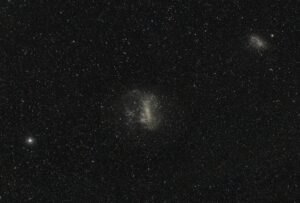An irregular dwarf galaxy
Large Magellanic Cloud
The Large Magellanic Cloud (LMC) is an irregular dwarf galaxy, a satellite and neighbor to the Milky Way galaxy, located approximately 163,000 light-years away from Earth. The LMC is one of the closest galaxies to the Milky Way and is visible to the naked eye from the Southern Hemisphere. It is classified as a barred irregular galaxy due to its lack of a defined spiral structure and the presence of a central bar-like region. The LMC spans about 14,000 light-years in diameter and contains billions of stars, making it a significant galaxy despite its small size compared to larger spirals like the Milky Way.
Astronomically, the Large Magellanic Cloud is an area of intense interest due to its rich array of astronomical phenomena, including star formation regions, supernova remnants, and nebulae. One of its most notable features is the Tarantula Nebula, the largest star-forming region in the Local Group of galaxies, which includes the Milky Way, LMC, and Small Magellanic Cloud. The LMC has also been a site for observing rare astronomical events, such as the supernova SN 1987A, which provided valuable data on stellar life cycles and the physical processes of supernovae.

The LMC’s relationship with the Milky Way and its neighboring Small Magellanic Cloud (SMC) provides a rich field for studying galaxy interactions, evolution, and dynamics. Gravitational interactions between these galaxies have shaped their structures over billions of years, contributing to the current appearance of the LMC and SMC. The LMC’s proximity allows astronomers to study these processes in detail, offering insights into the gravitational forces and evolutionary paths of galaxies. Overall, the Large Magellanic Cloud serves as a natural laboratory for understanding the complex interactions and evolution of galaxies within the universe.
Nikon D750 at 52 mm
Nelson, New Zealand

More Images

